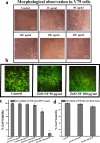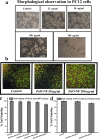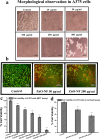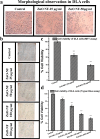Peony-shaped zinc oxide nanoflower synthesized via hydrothermal route exhibits promising anticancer and anti-amyloid activity
- PMID: 39736727
- PMCID: PMC11684297
- DOI: 10.1186/s40360-024-00830-x
Peony-shaped zinc oxide nanoflower synthesized via hydrothermal route exhibits promising anticancer and anti-amyloid activity
Abstract
Background: Cancer is the deadliest disease, and neurological disorders are also marked as slow progressive diseases, ultimately leading to death. Stopping two mouths with one morsel was the strategy that we used in this study.
Methods: We have synthesized peony-shaped zinc oxide nanoflowers (ZnO-NFs) and characterized them using various photophysical tools like UV-vis spectroscopy, zeta potential analysis, dynamic light scattering (DLS), FTIR, and scanning electron microscopy (SEM), and utilized these nanoflowers to monitor their anticancer and anti-amyloid activity. In vitro biocompatibility was assessed using fibroblasts and undifferentiated rat phaeochromocytoma cells, and in vivo, biocompatibility was estimated using haemolysis assay and zebrafish embryo development.
Results: The results demonstrated high biocompatibility of the as-synthesized ZnO-NFs up to a dose of 200 µg/ml. In vitro anticancer activity was evaluated using adherent (A375) and non-adherent (Dalton's Lymphoma Ascites, DLA) cancer cell lines. The results indicated that the ZnO-NFs significantly killed the cancer cells in a dose-dependent way, showing an extraordinary effect on DLA cells. The anti-amyloid activity in vitro was explored using a spectrum of assays that were hallmarks in anti-amyloid studies like ThT fluorescence assay, DLS, turbidity assay, atomic force microscopy (AFM), and SEM analysis. Excellent anti-amyloid activity was observed in vitro at 50 µg/ml of ZnO-NFs.
Conclusion: We can conclude from the above results that the as-synthesized ZnO-NFs have a dual role as an anticancer as well as an anti-amyloid agent. In the future, animal models can be used to study the efficacy of the ZnO-NFs in cancer inhibition and amyloid degradation.
Keywords: Amyloidosis; Anticancer activity; Biocompatibility; Zebrafish embryos; Zinc oxide nanoflowers.
© 2024. The Author(s).
Conflict of interest statement
Declarations. Ethical approval: The experiments on hemolysis assay were done by obtaining ethical clearance from the Institutional Human Ethical Committee (IHEC), Chettinad Academy of Research and Education (Ref No: IHEC-II/0655/24) on 26.04.2024. The experiments on zebrafish embryos were conducted by obtaining ethical clearance from the Institutional Animal Ethics Committee of Chettinad Academy of Research and Education (IAEC2/Proposal:162/A.Lr:124/Dt. 02.07.2024). Consent for publication: Not applicable. Competing interests: The authors declare no competing interests.
Figures








References
-
- Senthil R, Kavukcu SB, Vedakumari WS. Cellulose based biopolymer nanoscaffold: a possible biomedical applications. Int J Biol Macromol. 2023;246:125656. - PubMed
-
- Rochani A, Raveendran S. Theranostics: a new holistic Approach in Nanomedicine. Bionanotechnology in Cancer: Jenny Stanford Publishing; 2022. pp. 573–624.
-
- Desai N, Momin M, Khan T, Gharat S, Ningthoujam RS, Omri A. Metallic nanoparticles as drug delivery system for the treatment of cancer. Expert Opin Drug Deliv. 2021;18(9):1261–90. - PubMed
-
- Cherkasov VR, Mochalova EN, Babenyshev AV, Rozenberg JM, Sokolov IL, Nikitin MP. Antibody-directed metal-organic framework nanoparticles for targeted drug delivery. Acta Biomater. 2020;103:223–36. - PubMed
-
- Mercy DJ, Girigoswami K, Girigoswami A. A mini review on biosensor advancements-emphasis on quantum dots. Results Chem. 2023:101271.
MeSH terms
Substances
LinkOut - more resources
Full Text Sources
Miscellaneous

